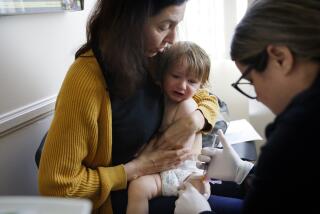Vaccination Campaign Targets Poor Families
- Share via
WASHINGTON — The Clinton administration will announce today a special campaign to increase immunization rates among millions of poor children who now lack protection against diphtheria, polio, measles and other potentially deadly diseases.
Nationwide, about 78% of American children are protected against these diseases by age 5, but in some communities with many low-income families, the rate is as low as 55%. Los Angeles County, with a figure of 76%, is close to the national average but still includes many “areas of need”--neighborhoods with lagging rates of immunization, according to government estimates.
Chicago; Dallas; Houston; Newark, N.J.; San Antonio; and Detroit all fall significantly behind the national average, at 71% or less. The San Diego County figure is 74%, but like Los Angeles, it includes many pockets of need. The government survey does not include Orange County.
The drive will reach families with unvaccinated children through the Agriculture Department’s Special Supplemental Nutrition Program for Women, Infants and Children, which provides food stamps and vitamins to pregnant women, new mothers and children until they turn 5. About 5 million children participate in the WIC program.
Parents Questioned at WIC Centers
When families visit a WIC center to enroll in the program or to pick up food stamps, they will be asked whether the children have had their shots for diphtheria, measles, mumps, polio and rubella.
Parents will be encouraged to go to their own doctors to have their children immunized. If they are uninsured, they will be eligible for free vaccinations at a public health clinic.
“This is the best point of contact, the best place to reach millions of children,” said Chris Jennings, special White House assistant for health policy.
The WIC centers will also begin keeping records on the immunizations of children.
Children enrolled in the WIC program typically have lower rates of immunization than other children of the same age group. Because they are from poor families, they are much less likely to have health insurance coverage that would pay for immunizations, and less likely to have a family doctor.
WIC is available nationwide to pregnant women, those who have just given birth, women who are breast-feeding and all children to the age of 5. The program eligibility rules vary by state. All those with income at or below the federal poverty line are covered, but states can offer coverage to families that make more but remain financially hard-pressed. California allows the maximum eligibility income permitted by the federal government--185% of the federal poverty standard, or $31,540 a year for a family of four.
Vaccination Rates Decline With Age
Low-income communities where many children have not received their shots “are at high risk for disease outbreaks such as the measles epidemic of 1989,” according to a White House report on the new program.
As part of today’s announcement, “the American Academy of Pediatrics will instruct all of its 55,000 members to emphasize the importance of timely immunizations to their WIC-eligible patients and encourage them to take their records with them when they visit the WIC clinic. . . ,” the White House said.
The Clinton administration has substantially expanded federal outlays for vaccinations during the past eight years. By age 2, about 90% of children have received key vaccines appropriate for their ages. The figure declines to 78% by age 5, when more immunizations are required.
The president is ordering the Agriculture Department and the federal Centers for Disease Control and Prevention to collaborate on a national plan to help identify children at risk and ensure that they get vaccinated.
The WIC clinics will be given computer software to enable them to keep information on the children, including schedules for immunizations.
Information on the importance of vaccinations will also be included in the educational programs for WIC participants, who are taught about breast-feeding, anemia and the dangers of lead poisoning, among other topics.
More to Read
Sign up for Essential California
The most important California stories and recommendations in your inbox every morning.
You may occasionally receive promotional content from the Los Angeles Times.













